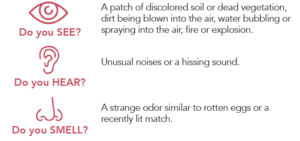Natural Gas Safety Tips
Natural gas is one of the safest and most reliable fuels available. However, it’s important that everyone in your household learn to safely operate and maintain your natural gas appliances. It’s easy if you follow these guidelines:
- When lighting a burner or oven with no pilot light, always light the match first, place it at the burner, and then turn the range knob.
- If a burner flame goes out, shut off the range knob, wait for the gas to dissipate, then relight the burner.
- Keep burners and range top clean.
- Keep the area around your appliances and meter free of all combustible materials. Keep air ducts clear.
- Inspect your furnace and water heater chimneys for loose- fitting joints.
- Read and understand all of the warning labels on your natural gas appliances.
- Install smoke alarms on each level of your house, including the basement. Replace batteries each year.
- Keep an active Class ABC fire extinguisher in the kitchen. Check the expiration date.
- You can also use baking soda to extinguish a grease fire. Small fires can be smothered with a wet towel or large pot cover.
- Create a plan for getting out of your house in case of fire or other emergency.
Suspect a gas leak?

Safe Access to Meters
Montana-Dakota Utilities encourages customers to inspect their natural gas meter on a regular basis to make sure it is not obstructed and that snow and ice have not built up on the meter. For more information, view our Meter Access and Safety page.
Safe Use of Portable Generators
For additional information regarding the safe use of portable gas generators during power outages click the link below.
Portable Generator: Carbon Monoxide Safety
Watch & Learn
Carbon Monoxide (CO) Safety
Carbon Monoxide (CO) is a toxic, colorless, odorless and tasteless gas that is produced by incomplete burning of natural gas, propane, kerosene or any other fossil fuel heat. CO comes from poorly functioning appliances, or appliances that are not vented or are incorrectly vented. Appliances such as furnaces, space heaters and even gas or charcoal grills pose a threat. Outdoor equipment such as portable generators, heaters and stoves also can create dangerous levels of CO in cabins and hunting/fishing shacks.
CO can be especially dangerous during the winter when homes are sealed up tight. The best ways to protect your family from CO are to:
- Ensure that fuel-burning appliances are installed, maintained and used properly and safely. That includes having an annual inspection of heating and venting equipment by a qualified technician.
- Never let a vehicle idle inside an attached garage, even with the door open. The CO from the exhaust can collect in the garage or go inside the home.
- CO is lighter than air and as it rises, it accumulates near ceilings. Detectors need to be placed higher on the walls or on the ceiling. Make sure you don’t place them where they can be easily overlooked. Battery-operated detectors need to be checked monthly. Putting them in a place that’s eye level or higher makes remembering to check your CO detector easier.
- With plug-in CO detectors, place them near the highest outlet you can. If the detector is too low, it may not warn you in time to keep you safe.
- Keep CO detectors 15 feet away from any gas burning appliance or fireplace, as well as, the connecting door from the home to an attached garage. Small doses of CO are higher around these areas, and may trigger false alarms.
- Don’t place a detector too close to a bathroom or kitchen. Excessive humidity interferes with their operation.
- Keep them away from direct sunshine.
- Avoid placing near windows that you open while grilling or mowing the lawn with a gas mower. Both of these devices emit large amounts of CO, and false alarms may sound.
- Put the first carbon monoxide detector near the master bedroom. As you add them, place one on each level of your home.
Warning Signs of CO Poisoning
Since the symptoms of CO poisoning are similar to the flu, victims often don’t realize the cause of their illness. CO poisoning symptoms can occur immediately or more gradually after longterm exposure. Symptoms do not include a fever, but do include:
- Dizziness
- Confusion
- Shortness of breath
- Nausea
- Headaches
- Fainting
- Tightness in the chest
If you suspect CO poisoning, get fresh air immediately. If exposure continues over a long period of time, CO poisoning can lead to brain damage or even death. If the symptoms are not accompanied by fever, if everyone in the family is ill, or you have pets acting strangely and the symptoms disappear when you leave the house, it could be CO poisoning.



 Subscribe to the MDU YouTube Channel.
Subscribe to the MDU YouTube Channel.